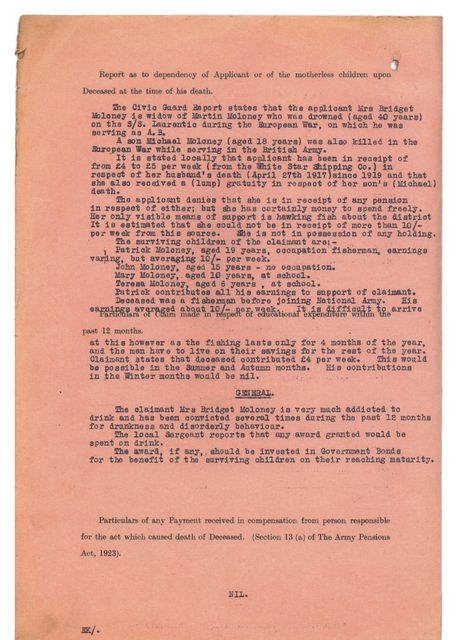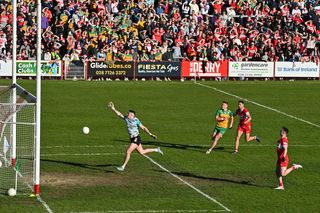The People’s Flag: The challenge of life in the turbulent period after war
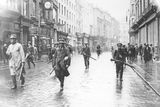

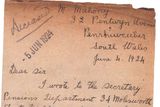
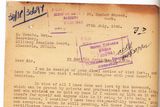
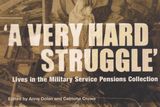
In recognition of the service of those who took part in the revolutionary period 1916-23, the Army Pensions Act (APA) 1923 was passed by the Free State Government to allow claims to be submitted for pensions and medals to those who applied.
In 1924 James Carrigan from Dublin applied for a pension from the Department of Defence.He served with Fianna Eireann in 1911,the Irish Volunteers in 1916,the IRA in 1920 and was a member of the National Army until 1923. After his unit was disbanded he found it very hard to get work but eventually got a job working on the Government Road Scheme with a pick and shovel for £2-10-0 a week. In his pension application he described how life was ‘a very hard struggle’ and looked forward ‘in anticipation’ for an early and satisfactory reply.
In another pension application, Dorothy Macardle wrote to Frank Aiken in 1934 on behalf of 70 year old Ellen Reardon,a mother of two sons;one was murdered in a bomb explosion in Cahirciveen and the surviving son was an invalid as a result of ill-treatment in jail during the Civil War. She received no compensation of any kind ,was described as very poor and Macardle states that ‘surely the families of prisoners murdered while in custody have or will have a claim ‘ to a pension.
Many of the life stories chronicled in this collection were greatly touched by personal tragedy.
In 1942 ,Mary Crowley from Cork made a number of appeals for an allowance or gratuity to the Pensions Board. Her numerous applications give an account of her descent into poverty stating ’ I have waited in vain for a service pension in accord with military service rendered over the period 1918/1923…..and I am unable to continue my present way of eking out a miserable existence and have nothing before me but the Workhouse.’
These stories give us a glimpse into the lives of the families who survived the violence and terror of the revolutionary period but were faced with the challenges of poverty and uncertainty in the decades after Independence.
‘A Very Hard Struggle’- Lives in the Military Service Pensions Collection is the latest publication from the Military Archives and the Department of Defence that chronicles the witness accounts of the men and women whose lives were utterly transformed by the hardship and loss they endured as a result of the revolution.This collection of the military pensions applications gives the reader an insight into the social,economic and political issues of the time.
It gives voice to the dependents of those who fought and died during and after the revolutionary period .These files reveal the experiences of families, especially the hardships endured by women and children who lost sons, brothers, husbands and fathers.They contain the untold stories of ordinary lives in extraordinary times trying to survive the burden of history that shaped their lives once the main breadwinner had been killed or severely wounded. Many of the voices are wives, widows, mothers and sisters as well as those whose lives were destroyed by their involvement in the revolutionary struggle from 1916 to 1923.
As a teaching resource , this collection introduces the student to stories of disappointment, shame, rage,ill health and physical and mental trauma and reveals much of the human cost of the revolution in the struggle for freedom.
To echo the words of James Carrigan, surviving for many,became ‘...a very hard struggle…’
The image on the cover of this collection is a photograph of Margaret Condon taken in 1921 in her house surrounded by the ruins of all her possessions.She submitted this photograph to the Pensions Board as proof of all she lost.She said ’Here’s all that’s left of me-in my Happy Home’.
‘After waiting for months,filled with hope’ Margaret’s application was rejected. ‘I did my Best for all these IRA Boys,I risked my own life- & I lost all I had-for their sakes. With her health now completely broken down, her husband’s application came to nought, she had ‘our 5 young children praying that Mama would get good news for the New Year’, but to no avail. A blunt note informed her ,like so many others, that’ you are not a person to whom the Act applies.’
Margaret’s pension application brings to life the story of a woman who lost all she had at twenty three and takes the reader on a personal journey that included her husband,five children,a doctor,two government ministers,several civil servants, her referees and a Miss Broderick who took her in after she lost all her possessions and gave her a bed in 1921. There are the men she hid,the police she feared and the friends she made ,along with the poverty and the shattered nerves she experienced over her lifetime. The image of her sitting among the ruins of her house is a stark reminder of the violence and destruction that families endured during the War of Independence.
Case Study 1 : Brigid Moloney
A claim was made for dependant’s allowance or gratuity by Brigid Moloney, 7 July 1924. Her particular circumstances are an illustration of a woman whose life was marred by tragedy and despair.
Her husband Martin drowned on the SS Laurentic in 1917 and her 18 yr old son Michael also died in the First World War. Another son ,Martin,who was in the National Army died from a sniper wound in 1922. She had four remaining children aged 19,15,10 and 6 years old.
A report linked to Brigid Moloney’s pension claim with comments about her personal circumstances
The eldest,Patrick brought in 10/- a week from fishing.It was recommended that she be given a gratuity of £50 which was sanctioned in October 1924 but the Army Pensions Department decided to consult the parish priest for additional information.In his letter,Reverend J.Glynn stated that Brigid was- ‘ a most degraded character. Drink,Immorality, Foulist invective and depraved.I had her interned in a Borstal Institute,6 years ago….To give her any money,especially a lump sum would be altogether undoing her. She has had from many sources ‘tons’. Starves her children….If I can she’ll be interned for a time next court. She was not depending on her son Martin.
The £50 award was withdrawn.
This is an example of how some claims were influenced by local reports. Reference is made to the fact that she had been convicted for drunkenness and disorderly behaviour and the local Sargent stated that any award granted would be spent on drink.
There was a process of Verification involved in all applications. The Army Pensions Board produced a second form in which responses to questions were typed when greater clarity was needed on a case.It was common for original claims to be witnessed by trusted local representatives who were usually schoolteachers or parish priests. In this case, Fr. Glynn was hugely influential in reversing the original award for Brigid Moloney’s £50.
Tasks:
⬤ SS Laurentic - Martin Moloney was one of 354 men who died in this tragic explosion.Students could be directed to research the story of the SS Laurentic which sank off the coast of Donegal after striking German mines on 25 January 1917.
Eg. The Western Front Association.
Donegal County Council ‘Remembering the Laurentic tragedy 100 years on’.
There is quite a story to explore here summed up in the title of one of many books written on the subject entitled
‘ A story of Gold, Crime and Intrigue’.
Case Study 2: Margaret Mahony.
Margaret Mahony’s husband Jeremiah was killed in Milstreet in Cork during the Civil war.She moved to Wales with her three children aged 12,10 and 8. On 30 May 1924 she wrote in her letter of application -
‘ I am actually starving…what in the name of God am I going to do I have nowhere to turn for food if I don’t get some help from the Irish free state before many days I will have to go into the union with my three orphans…..
Margaret Mahoney’s letter
Her letter is a heart wrenching example of the extreme poverty and destitution that some widows and their children fell into.
On 11 June 1924 the secretary of the office of the minister for defence pursued the case and appended this handwritten note -’PS. As this is a very necessitous case please furnish report with the least possible delay.The applicant is practically destitute with three little children depending on her.’ The administrative work continued and an award was eventually sanctioned.
However, Mrs. Mahony wrote to the Pensions Board on 10 October : ‘ ….the allowance I am getting is not sufficient to keep myself and my three children….I am not spending a penny wrong only doing my best to keep them as good as I can. I would sooner part with them and put them into a home rather than see them in poverty’.
On 23 October she was informed that she was already receiving the maximum allowance rate applicable in her case.
Task: Reference is made to the ‘Union’ in Margaret Mahony’s letter. Students could be asked to research the role of workhouses in the 19th and early 20th centuries. Why was there such shame attached to having to resort to the services of the Union?
Case Study 3: Mary Crowley.
‘Everyone in Cork knows what I had and what I am reduced to…’
Mary Crowley kept a boarding house in Cork and combined this business with running a newspaper shop. During the War of Independence and the Civil War the shop was used as an arms dump and for the exchange of dispatches. It was raided many times and one of her regular boarders was shot dead. Her business was ruined and for the next thirty years she struggled to survive. In her application she stated that her business was ruined by the shooting : ‘ My trade never recovered and although years later when everything was over I still felt the price of being associated with the IRA.’
Mary Crowley’s letter
By 1951 Mary Crowley was living in one room…’in what is little better than a hovel…’. A year later she wrote to the Pensions Board …’I am unable to continue my present way of eking out a miserable existence and have nothing before me but the Workhouse.’
She died in 1961 alone and devoid of help.She states that she was held in high esteem by ‘priests and professional men in this city’ and that she has’ been disgracefully treated ‘ as a result of the Board’s decision to reject her claim. She had sacrificed her home,her business and her personal safety to help the fight for Independence.
Task: The role of Women in the pursuit of Independence. Students could explore the activities of Cumann na mBan in their local area. The website of the Bureau of Military History has excellent resources on local and national organisations.
Summary
The Pensions applications gives us a view into the texture of peoples’ lives in the early decades after Independence.Rage,anger and despair are palpable from the letters as families and individuals attempt to deal with the emotional burden of the events from 1916-1923.
It was mainly women who were left with the burden of living and survival but the trauma experienced by the men who were participants in the fight for Independence is also recorded in this collection.
This archive is invaluable to the student of history because it provides us with a window into the past. We get to hear authentic ‘voices ‘describe the impact the harsh realities of conflict had on the everyday lives of those who were left to pick up the pieces of ordinary living in what was ,for some, dire economic circumstances.For those who found it ‘a very hard struggle’ this collection is a chronicle of disappointment and it is important that their voices are heard.
Deirdre Mac Mathúna
School of Education , TCD.
PRO of the History Teachers’ Association of Ireland (HTAI)
‘A Very Hard Struggle’-Lives in the Military Service Pensions Collection- Edited by Anne Dolan and Catriona Crowe.
Published by the Department of Defence. A special word of thanks to Cécile Chemin , Senior Archivist and Director of the Military Service Pensions Project.
Join the Irish Independent WhatsApp channel
Stay up to date with all the latest news






